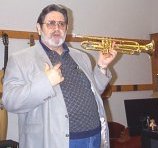
| O.J.'s Trumpet Page | Articles and reviews |

Thanks to Frank Brodal and NTF a clinic with Bobby Shew could take place at NMH in Oslo the 17th of April 1999. The clinic was followed by a great concert.
Background:
Bobby started the clinic by telling a bit about
his background as a trumpet player:
Students:
Students I see today are afraid to think. A lot
of teaching I see (at clinics, etc.) states that "This is the way" � I
am amazed � there is no such thing as "one way" to play the trumpet.
The important things I try to communicate to my students are:
How Bobby developed his knowledge:
As I said I never studied in the normal way - Arban
bored me. I just started out by playing. Things worked. I got jobs in better
and better bands. When I was in the Buddy Rich band there was a lead player
that Buddy did not like. A sax player said "Buddy why don�t you try Bobby?"
Buddy then said: "Bobby, get over there" Now, I started to get nervous,
I had never practiced high notes. The song was some simple shuffle stuff
and only one high F at the end. I put my knee up to get it and managed
to get through it � you know I could swing � and Buddy, being a drummer
wanted that. Buddy then said: "You are now my new lead player". I said
to him "I have no chops". "Go home and get it � have it for tomorrow",
Buddy then said. Well this was the beginning with problems for me, like
muscle problems, hernias � I�ve been through a lot of problems.
I now see that students do the same I did. Man, I have to help these kids. This is no fun memories.
To find out things I decided to buy books, Maggio, Gordon, Callet, etc. There are a lot of dangerous attitude among methods out there: "Do what I say". This is the egomania or "guru-syndromes".
Remember: "The best teacher is yourself"
You know earlier I though Maynard Ferguson was "inhumane", but because of Buddy Rich I had to learn how to do this. One day I had the courage to ask Maynard behind the stage: "How do you do this". He showed me a book called "The science of breath". This was a yoga book not a trumpet book.
Later I asked Bud Brisbois to show me his system. It was very opposite of the normal stuff, like lift your shoulders, etc. I went home and tried it. I played from the back of the Clarke book, the glissando exercise, a gliss from E to high E. Suddenly I went above that high E and ended on a big fat high A. This was my first high A. With this new system I also got up to double C.
Facts versus opinions:
I have done more than 25 years of research in this
field now. I have read a lot of medical books, etc. There are a lot of opinions
about breathing and misconception like breathe from the diaphragm etc. I
needed to know and a doctor showed me some facts. I have been talking to
a lot of people. Several of my students are in medicine, physics etc.
I always ask my students questions.
Some points:
Warm up:
Bobby Shew has an effective and quick
warm-up method.
2. Do "lip buzzing", that is isometric lip vibration, as if you play without the mouthpiece. Not more than 15 - 20 seconds each time. This is also a good test on the lip condition. He said that the lip position when buzzing is not equal to the lip position when playing on the instrument.
3. Play on the mouthpiece with a
clean sound.
He had discovered the flutter by watching people doing this when they where playing.
Breathing:
Bobby demonstrated his "6- step" breathing technique:
The important thing with step 1 is that it makes
the diaphragm drop down.
Students with pinched sound:
Often students came to see Bobby and wanted to play
difficult things right away. But he would first ask them to simply play
a low C. By listening to the sound of that note, Bobby could tell right
away if the student had potential for a double high C in his low note sound.
Very often students had a pinched sound that they had accepted as ok. Bobby now took up his trumpet and demonstrated how it sounded (playing with a pinched sound).
Now the first thing was to make the student aware of this by opening the sound. Bobby demonstrates, calling the pinched sound "NO-sound" and the open sound "YES sound".
He then played slowly: "YES � NO � YES � NO "
The next is to have the student play a simple ascending scale. Even if this first notes are open he often goes into a more pinched sound as he ascend.
A lot of people can hit a high note but it is pinched. Bobby demonstrates a pinched double high C � then an open one.
Do not become obsessed by high notes. The most important thing is good sound !
Tape yourself and listen closely.
Good practice habits:
Bobby did not get time to go into this subject deeply
but he pointed out some important points to remember:
15 minutes 4 times a day is much better than 1 hour practice.
Why?
Because after 15 minutes you still feel good and the body remember that "peek feeling"
Try this for a couple of weeks and see for yourself.